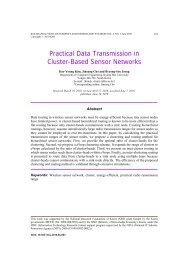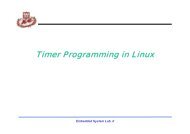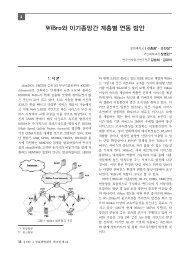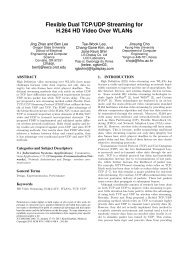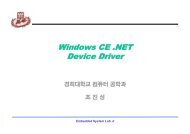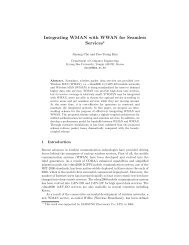OCDP : A WBAN MAC Protocol for Contention-based Medical and ...
OCDP : A WBAN MAC Protocol for Contention-based Medical and ...
OCDP : A WBAN MAC Protocol for Contention-based Medical and ...
- No tags were found...
Create successful ePaper yourself
Turn your PDF publications into a flip-book with our unique Google optimized e-Paper software.
Figure 2: The proposed <strong>WBAN</strong> <strong>MAC</strong> protocolFigure 1: Superframe structure in IEEE 802.15.42. RELATED WORKSince medical applications are the major issues of the<strong>WBAN</strong>, existing <strong>WBAN</strong> <strong>MAC</strong> protocol (i.e., TDMA <strong>and</strong>IEEE 802.15.4) have been proposed <strong>for</strong> medical applications.TDMA was studied in early stage of <strong>WBAN</strong> researcheswhich consist of the medical sensor devices [5, 6]. When a<strong>WBAN</strong> consists of various devices with different characteristics(e.g., medical or entertainment characteristics), TDMAmay not be adequate.IEEE 802.15.4 <strong>MAC</strong> [7] protocol, which is st<strong>and</strong>ard <strong>for</strong>wireless sensor networks, is considered <strong>for</strong> the <strong>WBAN</strong> [8,9]. IEEE 802.15.4 <strong>MAC</strong> uses a superframe structure in abeacon-enabled mode as shown in Figure 1. The superframeduration (SD) as an active period is divided into 16 equalsizedtime slots. A guaranteed time slot (GTS) is allocatedin one or more slots to a device. If lots of GTS slots are allocated,a contention access period (CAP) is decreased. Inaddition, the GTS of IEEE 802.15.4 allows at most 7 devices.In general, IEEE 802.15.4 needs more CAP slots sothat a coordinator may increase a value of SO <strong>for</strong> the extensionof the CAP duration. By increasing superframe order(SO), however, the GTS slots also increases together. Thus,unnecessary increase of the size of GTS slots exponentially.Since the medical application is the focus of the <strong>WBAN</strong>,as we identified in Section 1, existing <strong>MAC</strong> protocols aregenerally used in the <strong>WBAN</strong>. In <strong>WBAN</strong> environments, however,CE devices may generate bursty data with event-drivenmethods <strong>and</strong> connect with the <strong>WBAN</strong> occasionally. Thus,existing <strong>MAC</strong> protocols using periodic sleep method <strong>for</strong> lowpower consumption have the latency due to the periodicsleep. That is, since existing <strong>MAC</strong> protocols are designed <strong>for</strong>sensor devices required low power consumption, the <strong>WBAN</strong><strong>MAC</strong> protocol should be designed <strong>for</strong> both medical <strong>and</strong> CEapplications flexibly.3. PROPOSED <strong>WBAN</strong> <strong>MAC</strong> PROTOCOLAs mentioned earlier, since providing the flexibility <strong>for</strong>various applications is the main goal, we propose a hybrid superframestructure <strong>MAC</strong> protocol <strong>for</strong> the <strong>WBAN</strong>. As shownin Figure 2, the proposed <strong>WBAN</strong> <strong>MAC</strong> protocol focuses onthe following ideas:First, we exploit the <strong>OCDP</strong> <strong>for</strong> the flexible ranges of thelatency. In IEEE 802.15.4, the Inactive period is determinedby beacon order (BO) <strong>and</strong> SO in a beacon <strong>and</strong> all devicessleep in the Inactive period. If CAP is insufficient due toincreased temporary traffics, IEEE 802.15.4 exp<strong>and</strong>s CAPby increasing SO in a beacon. However, if SO increases,the size of GTS slots also exponentially increases as shownin Figure. 1. To support the <strong>WBAN</strong> devices required latency<strong>and</strong> the sporadic traffics of CE applications flexibly,the <strong>OCDP</strong> is proposed.Second, we exploit the 4-mode Opportunity period.The 4-mode Opportunity period has 4 kinds of design patterns<strong>for</strong> the Opportunity period. <strong>WBAN</strong> devices requestthe Opportunity period through transmitting the OCM(opportunity contention message) frame in the subperiodof RO (request or opportunity) in the <strong>OCDP</strong>.The coordinator selectively decides the Opportunity periodamong the 4-mode Opportunity period, <strong>and</strong> then the coordinatorbroadcasts a OCM ACK (acknowledgement)frame in the AO (acknowledgement of Opportunity)subperiod in the <strong>OCDP</strong> as shown in Figure 3.3.1 <strong>OCDP</strong> (Opportunistic <strong>Contention</strong> DecisionPeriod)Figure 3 depicts the proposed <strong>OCDP</strong>. Unlike the IEEE802.15.4 <strong>MAC</strong> protocol, the proposed <strong>MAC</strong> protocol hasthe <strong>OCDP</strong>. The coordinator could decide whether the Inactiveperiod or the Opportunity period in the <strong>OCDP</strong>. Whenbursty data increase temporarily, the latency is inevitable inperiodic sleep mechanisms such as the IEEE 802.15.4 <strong>MAC</strong>.In the proposed <strong>MAC</strong> protocol, the <strong>OCDP</strong> provides the opportunities<strong>for</strong> switching from the Inactive period to theOpportunity period.Figure 3: The detailed <strong>OCDP</strong>The <strong>OCDP</strong> consists of both the RO subperiod <strong>and</strong> theAO subperiod. To use those of subperiods, the proposed<strong>WBAN</strong> <strong>MAC</strong> protocol provides two request frames namedOCM <strong>and</strong> OCM ACK. The <strong>WBAN</strong> devices may request theOpportunity period through transmitting the OCM frame tothe coordinator. On the other h<strong>and</strong>, the coordinator broadcaststhe OCM ACK frame including the selected Opportunityperiod among the 4-mode Opportunity period.The RO subperiod is designed <strong>for</strong> transmitting the OCM



